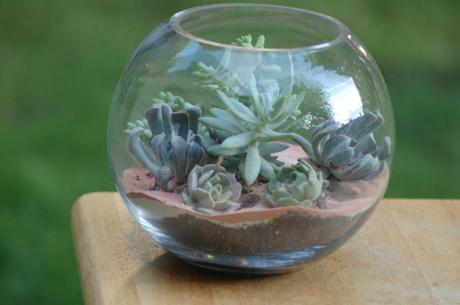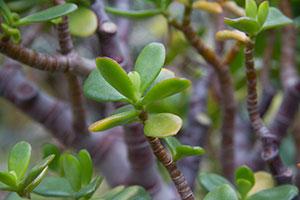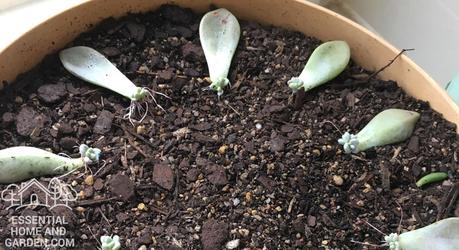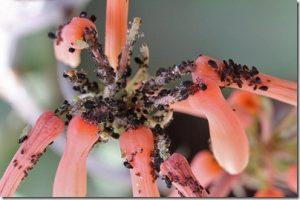Succulents are a very versatile plant that can be planted in a variety of locations. Each type of garden is different so it is important to put some time into researching what succulents are suitable for your desired location.
It is a good idea to talk to the staff at your local nursery and get their advice, but we have some generic advice we can give you here to get you started.
How to Plant Succulents in a Garden
If you have the right weather conditions, then the best place to plant succulents is outdoors in your garden.
Choosing the right time of year to plant is important, Succulents are best planted in fall and spring. It is best to avoid planting in winter due to the cold temperatures.
Location: Find somewhere in your garden that gets a fair bit of direct sunlight if possible but also some shade during the hottest hours of the day. Finding the right mix of sun and shade is important if you want your succulents to thrive.
Prepare the Soil: Remove any weeds from the existing soil and break it up. Succulents require good drainage, and we can create this by mixing equal parts of sharp builders sand and a larger material such as the existing garden soil or a cactus potting mix.
Planting and layout: Plant your succulents in a layout that suits your plant choice and garden style. This is a matter of doing some quick research yourself. Do NOT water your succulents yet! It is important to note that you should not mulch your garden with moist leaf litter, instead use pebbles or river stones.
Watering: After 1 week has passed, you may water your plants. The reason we wait a week is to allow the roots to recover from the stress of being replanted and they also harden during this time.
Water the soil until it is completely moist but not soaking. How frequently you water them from here depends on the type of succulents you have chosen, but generally you should water them 2 times a month during Spring and Summer, and once every second month in Autumn and Winter.
Before watering your plants always check if they need it - if the soil is completely dry then it is time to water, if it is even a little moist then hold off on giving your succulents a drink. If you over water you will cause your plants to rot and die.
Fertilize: Do so once in the spring and once in summer. A suitable fertilizer is a half strength phosphorous-rich standard houseplant fertilizer.
Maintain: Keeping your garden free from weeds is an important part of how to care for succulents, so be vigilant with this!
Planting Succulents in Pots
Succulents are great indoor plants and planting them in pots is common practice, they absolutely love growing in pots and there is no reason you should not take advantage of this fact!
Location: Choose a spot that has plenty of natural light, just be careful that the plant is not going to get too hot if direct sun hits it through the window as it may get sunburned.
Choose a pot: Choosing the right pot is quite important. The most important feature the pot must be drainable. As we have mentioned numerous times, succulents need excellent drainage so ensure your pot choice includes drainage holes.
Prepare the soil: Remember that the key to a happy succulent is for the pot to be well drained. So we want to mix up roughly equal parts of sharp builders sand and a cactus potting mix.
But before we add our mix to the pot, we want to add a half-inch layer of charcoal in the bottom of the pot. This will ensure that we have good drainage and water won't get caught in the packed in soil at the bottom.
Planting and Layout: Plant your succulents into your pot/container in a layout that suits your plant choice and garden style. Because succulents have small roots make sure you plant them as shallow as possible, with a whole just big enough to cover the root ball. It is important to do some some quick research yourself as to what layout suits your plant choice.
Do NOT water your succulents yet! It is important to note that you should not mulch your garden with moist leaf litter, instead use pebbles or river stones.
Watering: After 1 week has passed, you may water your plants. The reason we wait a week is to allow the roots to recover from the stress of being replanted and they also harden during this time.
Water the soil until it is completely moist but not soaking.
How frequently you water them from here depends on the type of succulents you have chosen, but generally you should water them 2 times a month during Spring and Summer, and once every second month in Autumn and Winter.
Before watering your plants always check if they need it - if the soil is completely dry then it is time to water, if it is even a little moist then hold off on giving your succulents a drink. If you over water you will cause your plants to rot and die.
Fertilize: Many people do not bother fertilizing indoor succulents, you can choose to do so if you like. Fertilize once in the spring and once in summer. A suitable fertilizer is a half strength phosphorous-rich standard houseplant fertilizer.
Planting Succulents in Terrariums
Not Recommended
Getting Succulents to stay alive in terrariums can be quite difficult due to the humidity and often there is no drainage.
Terrariums are all the rage at the moment, everyone wants their own little ecosystem in a pretty glass container in their house. Unfortunately, most succulents do not do well in terrariums, but we will provide some general tips to give you the best fighting chance.
There are many DIY Terrarium Kits available if you want it to be as easy as possible, but if you want to design your own, then we have a few tips for you to follow.


Tips on giving your succulents the best chance in a terrarium:
Succulent Care
Follow these straight to the point guides to ensure your succulents look their best.
Succulent Watering Requirements


Make sure that they are in a well drained location as permanently wet soil will cause your succulent to rot and die.
An important point of how to care for succulents, is to not water in winter. This will allow the soil to dry out enough even though the temperatures are colder.
Feeding Succulents
Fertilizing of succulents should be carried out once in spring and once again in late summer. When it comes to fertilizing succulents there are many different methods. You may need to experiment to find out what works for you, but here is one of our favorite methods:
- Get hold of a low-balanced soluble fertilizer (an 8-8-8 or a 10-10-10 is good) and disolve some into about 1 gallon of water. You probably do not want to use the recommended dose that the packet will tell you, about half the usual dose is fine for succulents.
- Slowly pour the mixed fertilizer and water on top your plants until the excess water starts to drain from the bottom of the container.
Remember, that this counts as watering your plants, and do this only when the soil is completely dry.
Propagating Succulents
Succulents are very easy to propagate, and that's great news because who doesn't want a whole garden full of the beautiful plants!
A succulent that is becoming too leggy is perfect to propagate from.
Follow these steps to propagate a succulent from a leaf
- Start by removing the lower leaves from your plant carefully. Hold the leaf between two fingers and move it from side to side until you feel the leave snap of. Make sure you get the entire leaf.
- When you have removed the lower leaves, your succulent will be left as a rosette of leaves on the top on a long bare stem. Use a pair of scissor and cut the rosette off about half way down the stem.
- Now we need to let place the leaves and rosette in a cool dry place and let the ends dry out a bit and callous over. Do not skip this step, it is very important.
- Once the ends are dry enough, then can be placed on some cactus soil. Make sure it is well drained. Place the leaves on the soil indoors near a window.
- It will take a few weeks, but you will start to notice little roots growing from the ends of the leaves. After that you will notice little plants growing, they are so cute - just like a mini succulent.


- You do not need to water them much at all up until now, if you feel the need to then make sure it is with a light spray only that will not dislodge the leaves.
- At this point, whenever you notice the soil is totally dry - give them a good soak. Do not water them too often or they will rot and die.
- Let the plants grow until the original leaf starts to noticeably die off, then it is time to carefully remove the original leaf in the same way you removed it from the original plant. Just be careful not to accidentally remove the roots with the leaf.
- The baby plant can then be placed in its own pot with some fresh cactus soil
Not every leaf will grow into a plant, so simply discard the leafs that do not work. You will have plenty from your new succulents to try again with soon!
Problems with your Succulent


Succulents dislike extended periods of wet and cold conditions - so keep this in mind when choosing where and when you plant them. During especially wet winters you may notice some black spots on the leaves, just remove these leaves and your plant should be fine.
If you notice aphids or mealy bugs then treat them with an insecticide promptly, or if you prefer - go the natural option.
